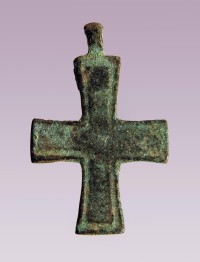The formation of Slavic states
During the era of the migration of nations, significant changes in ethnic settlement and civilisation took place in the Carpathian valley.
By the 5th century Slavic tribes had settled the area, occupying lands abandoned by Germanic tribes fleeing the Huns and their allies. They were followed by the nomadic Avars who conquered the surrounding Slavs. The Slavs fought against Avar hegemony and after a successful uprising they created, at least for a short period, the first known supra-tribal formation of Western Slavs – Samo’s Empire (623--658). Thereafter the standard of living of Slavs on the Central Danube grew steadily, and following the defeat of the Avars by Frankish king Charles the Great, the first state formation of Western Slavs emerged.
In the late 8th and early 9th centuries the Moravian Principality was established in Moravia and the Nitra Principality was set up in western Slovakia. According to written documents, Prince Pribina of Nitra consecrated the first church in the eastern part of the Central Europe in 828. However, brass bells and gold-plated plaques with Latin inscriptions discovered in Bojná, Topoľčany suggest that a similar church was also built there, at a much earlier date.
In 833 serious power conflicts arose, culminating in the defeat of Pribina of Nitra by Moravian prince Mojmír and the unification of the two principalities to create the state which we now know as Great Moravia (Byzantine emperor Constantine Porfyrogenetos referred to the state by this name in the middle of the 10th century). Great Moravia occupied the space between the Byzantine, Bulgarian and Frankish empires.
 Christianity had been spread by Frankish missionaries in the region for some time; however a real turning point in the development of Slavic civilisation occurred after 863 when, in an attempt to eliminate Great Moravia’s political dependence on the Eastern Frankish Empire, Prince Rastislav of Great Moravia requested Byzantine emperor Michael III and Patriarch Photius to send missionaries to evangelise his Slavic subjects. This task was entrusted to Thessalonian scholars and missionaries Saints Cyril (aka Constantine) and Methodius, whose mission to Great Moravia was to play a uniquely cultural role.
Christianity had been spread by Frankish missionaries in the region for some time; however a real turning point in the development of Slavic civilisation occurred after 863 when, in an attempt to eliminate Great Moravia’s political dependence on the Eastern Frankish Empire, Prince Rastislav of Great Moravia requested Byzantine emperor Michael III and Patriarch Photius to send missionaries to evangelise his Slavic subjects. This task was entrusted to Thessalonian scholars and missionaries Saints Cyril (aka Constantine) and Methodius, whose mission to Great Moravia was to play a uniquely cultural role.It was Cyril and Methodius who designed the first Slavic (Glagolitic) script and the standard language (old Slavic) into which they also translated the fundamental liturgical texts. They also established a seminary. Methodius’ relationship with the Pope in Rome helped the old Slavic language to become recognised as a liturgical language, and as archbishop he built a church administration in Great Moravia. Thanks to these changes, the Great Moravian Slavs became part of the civilised world.
The old Slavic liturgy and script were pushed out of Central Europe, but thanks to Methodius’ students in Bulgaria, they were permanently established with the eastern and southern Slavs. In 1980 Saints Cyril and Methodius were proclaimed co-patrons of Europe, together with Saint Benedict of Nursia, by Pope John Paul II.
Great Moravia reached the peak of its power and territorial holdings under the reign of Svätopluk. He first repulsed the attacks of the Eastern Frankish Empire and gradually conquered Vistula, Silesia, Bohemia, Lusatia, Tiszaland and Transdanubia.
However the heyday of Great Moravia was brief. Internal conflicts and the pressure of Hungarian tribes led to its downfall at the beginning of the 10th century.
